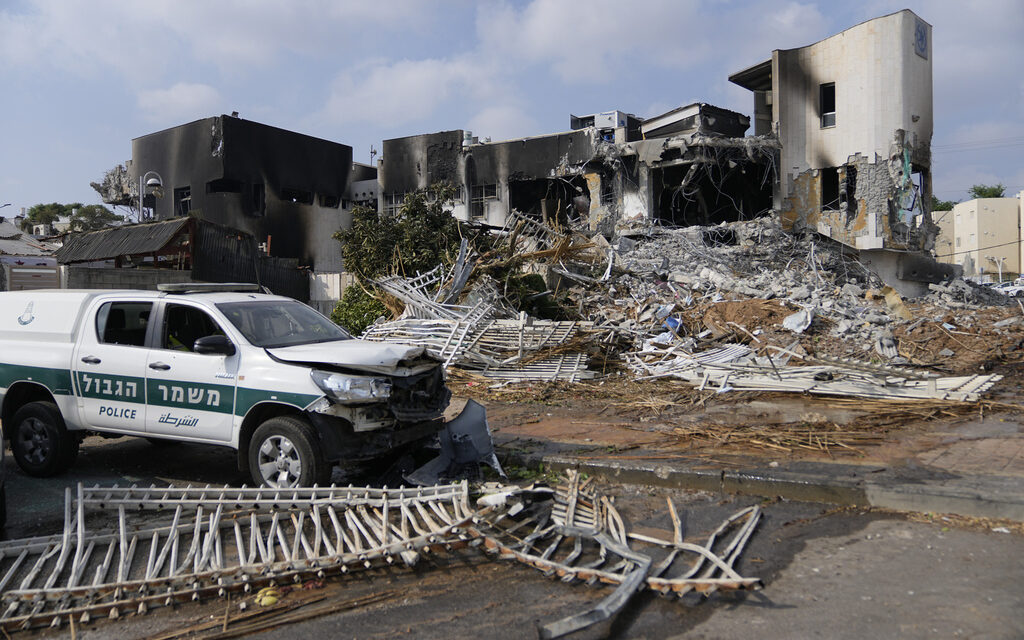By Tia Goldenberg and Wafaa Shurafa.
The Associated Press
TEL AVIV, Israel (AP) — Israeli soldiers battled Hamas fighters in the streets of southern Israel on Oct. 8 and launched retaliation strikes that leveled buildings in Gaza, while in northern Israel a brief exchange of strikes with Lebanon’s Hezbollah militant group raised fears of a broader conflict.
There was still some fighting underway more than 24 hours after an unprecedented surprise attack from Gaza, in which Hamas militants, backed by a volley of thousands of rockets, broke through Israel’s security barrier and rampaged through nearby communities. At least 600 people have reportedly been killed in Israel — a staggering toll on a scale the country has not experienced in decades — and more than 300 have been killed in Gaza.
The militants also took captives back into the coastal Gaza enclave, including women, children and the elderly, whom they will likely try to trade for thousands of Palestinian prisoners held by Israel. Secretary of State Antony Blinken told CNN’s “State of the Union” that the U.S. is working to verify reports that “several” Americans were killed or are missing.
The high death toll, multiple captives and slow response to the onslaught pointed to a major intelligence failure and undermined the long-held perception that Israel has eyes and ears everywhere in the small, densely populated territory it has controlled for decades.
Israeli Prime Minister Benjamin Netanyahu said the country was at war and would exact a heavy price from its enemies. His Security Cabinet officially declared the country at war in an announcement on Oct. 8, saying the decision formally authorizes “the taking of significant military steps.”
The implications of the announcement were not immediately clear. Israel has carried out major military campaigns over the past four decades in Lebanon and Gaza that it portrayed as wars, but without a formal declaration.
Yohanan Plesner, the head of the Israel Democracy Institute, a local think tank, said the decision is largely symbolic, but “demonstrates that the government thinks we are entering a more lengthy, intense and significant period of war.”
A major question now was whether Israel will launch a ground assault into Gaza, a move that in the past has brought intensified casualties. Netanyahu vowed that Hamas “will pay an unprecedented price.” But, he warned, “This war will take time. It will be difficult.”
Civilians paid a staggering cost for the violence on both sides. Several Israeli media outlets, citing rescue service officials, said at least 600 people were killed in Israel, including 44 soldiers, while officials in Gaza said 313 people had died in the territory. Some 2,000 people have been wounded on each side. An Israeli official said security forces have killed 400 militants and captured dozens more.
Israeli TV news aired a stream of accounts from the relatives of captive or missing Israelis, who wailed and begged for assistance amid a fog of uncertainty surrounding the fate of their loved ones. In Gaza, residents fled homes near the border to escape Israeli strikes, fleeing deeper inside the territory after warnings in Arabic from the Israeli military.
In neighboring Egypt, a policeman shot dead two Israeli tourists and an Egyptian at a tourist site in Alexandria, the Interior Ministry said. Egypt made peace with Israel decades ago, but anti-Israel sentiment runs high in the country, especially during bouts of Israeli-Palestinian violence.
The flare-up on Israel’s northern border also threatened to draw into the battle Hezbollah, a fierce enemy of Israel’s which is backed by Iran and estimated to have tens of thousands of rockets at its disposal. Hezbollah fired dozens of rockets and shells on Oct. 8 at three Israeli positions in a disputed area along the border and Israel’s military fired back using armed drones. Two children were lightly wounded by broken glass on the Lebanese side, according to the nearby Marjayoun Hospital.
Rear Adm. Daniel Hagari, an Israeli military official, told reporters the situation at the northern border was calm after the exchange. But he said fighting was still underway in the south and that there were still hostage situations there.
He said troops had moved into every community near the Gaza frontier, where they planned to evacuate all civilians and scour the area for militants.
“We will go through every community until we kill every terrorist that is in Israeli territory,” he said. In Gaza, “every terrorist located in a house, all the commanders in houses, will be hit by Israeli fire. That will continue escalating in the coming hours.”
Hamas said that overnight it had continued to send forces and equipment into “a number of locations inside our occupied territories,” referring to Israel. Hamas-linked media reported that the son of Nizar Awadallah, a senior political official, was killed. The Islamic militant group has not reported any senior members being captured, killed or wounded.
The surprise attack Oct. 7 was the deadliest on Israel in decades. In an assault of startling breadth, Hamas gunmen used explosives to break through the border fence enclosing Gaza, then crossed with motorcycles, pickup trucks, paragliders and speed boats on the coast.
They rolled into as many as 22 locations outside the Gaza Strip early Saturday morning, including towns and other communities as far as 24 kilometers (15 miles) from the Gaza border, while Hamas launched thousands of rockets at Israeli cities.
“Israel is waking up this morning to a terrible morning,” said Lt. Col. Richard Hecht, an Israeli military spokesman. “There are a lot of people killed … children, grandmothers, families, bodies.”
Israeli media said at least 600 people were killed and 2,000 wounded in the Oct. 7 attack. Hamas fighters took an unknown number of civilians and soldiers captive into Gaza, and a line of Israelis with missing relatives snaked outside a police station in central Israel to supply investigators with DNA samples and other means that could help identify their family members.
Israel struck 426 targets in Gaza, its military said, flattening residential buildings in giant explosions.
Among the 313 killed in Gaza were 20 children, and close to 2,000 people were wounded, the Palestinian Health Ministry said. UNRWA, the U.N. agency for Palestinian refugees, said more than 20,000 Palestinians left Gaza’s border region to head further inside the territory and take refuge in U.N. schools.
In a televised address the night of the attack, Israeli Prime Minister Benjamin Netanyahu said the military will use all of its strength to destroy Hamas’ capabilities.
“Get out of there now,” he told Gaza residents, who have no way to leave the tiny, overcrowded Mediterranean territory. Gaza’s 2.3 million people have endured a border blockade, enforced to varying degrees by Israel and Egypt, since Hamas militants seized control in 2007.
In Gaza, much of the population was thrown into darkness the night of Oct. 7 as Israel cut off electricity and said it would no longer supply power, fuel or other goods to the territory.
Hamas said it had planned for a long fight.
“We are prepared for all options, including all-out war,” the deputy head of the Hamas political bureau, Saleh al-Arouri, told Al-Jazeera TV.
Israel has a history of making heavily lopsided exchanges to bring captive Israelis home. The military has confirmed that a “substantial” number of Israelis were abducted Oct. 7 without giving an exact figure.
An Egyptian official said Israel has sought help from Cairo to ensure the safety of the hostages, and that Egypt’s intelligence chief had contacted Hamas and the smaller but more radical Islamic Jihad group, which also took part in the incursion, to seek information. Egypt has often mediated between the two sides in the past.
The official said Palestinian leaders claimed that they don’t yet have a “full picture” of hostages, but said those who were brought into Gaza were taken to “secure locations” across the territory.
“It’s clear that they have a big number — several dozens,” said the official, who asked not to be identified because he was not authorized to brief media.
Egypt also spoke with both sides about a potential cease-fire, but the official said Israel was not open to a truce “at this stage.”
In Iran, which has long supported Hamas and other militant groups, President Ebrahim Raisi praised the “legitimate defense” of the Palestinian nation and said Israel and its supporters “must be held accountable.” Raisi spoke by phone with Hamas leader Ismail Haniyeh and Islamic Jihad leader Ziad al-Nakhalah, the state-run IRNA news agency reported Oct. 8.
The shadowy leader of Hamas’ military wing, Mohammed Deif, said the assault, named “Operation Al-Aqsa Storm,” was in response to the 16-year blockade of Gaza, and a series of recent incidents that have brought Israeli-Palestinian tensions to a fever pitch.
Over the past year, Israel’s far-right government has ramped up settlement construction in the occupied West Bank, Israeli settler violence has displaced hundreds of Palestinians there, and tensions have flared around the Al-Aqsa mosque, a flashpoint Jerusalem holy site.
President Joe Biden said from the White House that the U.S. “stands with the people of Israel in the face of these terrorist assaults,” and said Israel has the right to defend itself.
___
Shurafa reported from Gaza City. Associated Press writers Isabel DeBre, Julia Frankel and Josef Federman in Jerusalem; Issam Adwan in Rafah, Gaza Strip; Bassem Mroue in Beirut and Samy Magdy in Cairo and Amir Vahdat in Tehran, Iran contributed to this report.
The post Israel battles Hamas militants as country’s death toll from mass incursion reaches 600 appeared first on AFRO American Newspapers .











